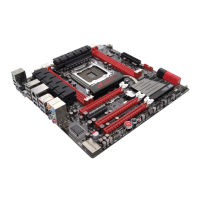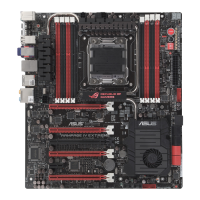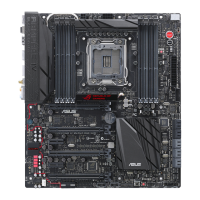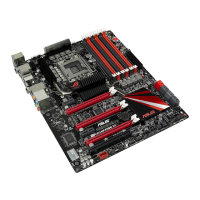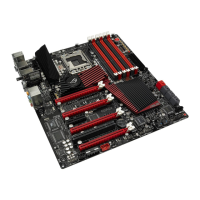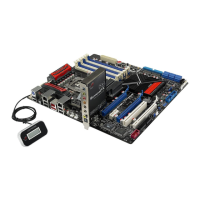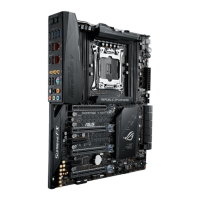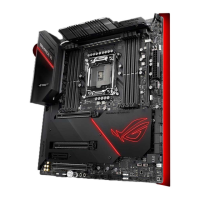Do you have a question about the Asus Rampage IV Formula and is the answer not in the manual?
Provides crucial safety precautions for handling electrical components and preventing shock hazards.
Details safe practices for operating the motherboard and handling the product to prevent damage or malfunction.
Provides essential precautions and safety guidelines before installing hardware.
Explains the CPU socket and installation considerations for the Intel LGA2011 socket.
Explains the ATX power connectors for supplying power to the motherboard.
Outlines the process of assembling a PC system with the motherboard.
Provides step-by-step instructions for installing the CPU into the LGA2011 socket.
Details how to install the CPU heatsink and fan assembly.
Explains the procedure for installing and removing memory modules (DIMMs).
Guides the user on how to mount the motherboard inside the PC chassis.
Illustrates how to connect the ATX power supply cables to the motherboard.
Guides on installing expansion cards like graphics cards into PCIe slots.
Provides initial steps for powering on and setting up the system for the first time.
Explains how to enter and navigate the BIOS setup utility.
Details the Advanced Mode for comprehensive BIOS configuration options.
Covers the Extreme Tweaker menu for overclocking and performance tuning.
Explains the DIGI+ Power Control feature for adjusting VRM voltage and frequency.
Details settings related to CPU performance tuning like CPU Ratio and Turbo Mode.
Explains how to adjust CPU VCORE voltage in manual and offset modes.
Details how to adjust CPU VCCSA voltage settings.
Covers system security settings, including administrator and user passwords.
Displays CPU-related information and allows configuration of CPU features.
Allows configuration of SATA devices, including IDE, AHCI, and RAID modes.
Allows enabling or disabling onboard devices like Audio, LAN, and USB controllers.
Displays system temperature, power status, and allows fan speed control.
Allows configuring CPU and chassis fan speeds using profiles or manual settings.
Allows changing system boot options, including boot device priority.
Offers options to load defaults, save, or discard BIOS changes and exit.
Provides instructions and utilities for updating the motherboard BIOS.
Details the EZ Flash 2 Utility for updating BIOS via a USB flash drive.
Explains the CrashFree BIOS 3 utility for recovering corrupted BIOS files.
Explains the USB BIOS Flashback feature for updating BIOS under standby power.
Explains TurboV EVO for CPU frequency and voltage adjustment.
Details DIGI+ PowerControl for VRM voltage and frequency modulation.
Manages and updates motherboard BIOS versions.
Explains RAID configurations and Intel Rapid Storage Technology support.
Covers requirements and installation for AMD CrossFireX multi-GPU technology.
Covers requirements and installation for NVIDIA SLI multi-GPU technology.
| ECC | No |
|---|---|
| Non-ECC | Yes |
| Memory channels | Quad-channel |
| Number of memory slots | 4 |
| Supported memory types | DDR3-SDRAM |
| Maximum internal memory | 32 GB |
| Supported memory clock speeds | 1066, 1333, 1600, 1800, 2000, 2133, 2400 MHz |
| Processor socket | LGA 2011 (Socket R) |
| Processor manufacturer | Intel |
| Compatible processor series | Intel Core i7, Intel Core i7 Extreme Edition |
| USB 2.0 connectors | 3 |
| Number of Parallel ATA connectors | 0 |
| USB 3.2 Gen 1 (3.1 Gen 1) connectors | 1 |
| Manageability features | WfM2.0, DMI2.0, WOL by PME, WOR by PME, PXE |
| BIOS type | UEFI |
| ACPI version | 2.0a |
| BIOS memory size | 64 Mbit |
| eSATA ports quantity | 2 |
| USB 2.0 ports quantity | USB 2.0 ports have a data transmission speed of 480 Mbps, and are backwards compatible with USB 1.1 ports. You can connect all kinds of peripheral devices to them. |
| Component for | PC |
| Audio output channels | 7.1 channels |
| Motherboard form factor | ATX |
| RAID levels | 0, 1, 5, 10 |
| Supported storage drive interfaces | SATA II, SATA III |
| Cables included | SATA |
| Parallel processing technology support | 2-Way SLI, 3-Way SLI, Hybrid CrossFireX, Quad-GPU CrossFireX, Quad-GPU SLI |
| PCI Express slots version | 3.0 |
| Networking features | 10/100/1000 Mbit/sec |
| Ethernet interface type | Gigabit Ethernet |
| Depth | 244 mm |
|---|---|
| Width | 305 mm |
